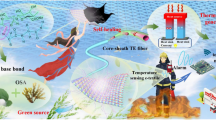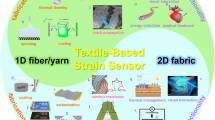Abstract
This research has designed and prepared a protective clothing layer by integrating porous silica aerogel with nonwoven fabrics for simultaneous chemical and thermal protection. Protective interlining having resistance to heat and liquid chemical penetration was developed by sandwiching randomly distributed aerogel particles between viscose nonwoven fabric layers. The nonwoven layer and aerogel particle layer were explored by analysing fabric surface morphology. Physical characterization of the test specimens revealed that the weight and thickness of fabric increased after the integration of aerogel particles. Consequently, improved chemical resistance and thermal resistance were observed in the aerogel–nonwoven fabrics with higher aerogel concentration. For clothing comfort, the high air permeability indicated sufficient breathability by transferring air and water vapour from the body to the atmosphere and vice versa through apparel. Improved evaporative transmittance and cooling index of aerogel–fabrics suggested that the fabric will create a favourable thermal comfort microenvironment between the skin and apparel. For wear comfort regarding wet clinginess, the high water uptake and evaporation rate of the fabric specimens indicated their ability to retain and evaporate large amounts of perspiration vapour in a hot and humid atmosphere. The overall performance of the aerogel–nonwoven fabrics suggested that the integration of silica aerogel with viscose nonwoven fabric is a prospective approach for developing protective interlining that will provide reliable chemical and thermal protection as well as adequate clothing comfort to the wearer.











Similar content being viewed by others
References
Yu Y, Wu X, Fang J (2015) Superhydrophobic and superoleophilic “sponge-like” aerogels for oil/water separation. J Mater Sci 50(15):5115–5124. https://doi.org/10.1007/s10853-015-9034-9
Shaid A (2018) Incorporation of aerogel and phase change material in textiles for thermal protection. RMIT University, Melbourne, p 204
Dorcheh AS, Abbasi M (2008) Silica aerogel; synthesis, properties and characterization. J Mater Process Technol 199(1–3):10–26
Amonette JE, Matyáš J (2017) Functionalized silica aerogels for gas-phase purification, sensing, and catalysis: a review. Microporous Mesoporous Mater 250:100–119
Venkataraman M et al (2018) Electrospun nanofibrous membranes embedded with aerogel for advanced thermal and transport properties. Polym Adv Technol 29(10):2583–2592
Feng J et al (2016) Silica–cellulose hybrid aerogels for thermal and acoustic insulation applications. Colloids Surf A 506:298–305
Hrubesh L, Keene L, Latorre V (1993) Dielectric properties of aerogels. J Mater Res 8(7):1736–1741
Chen-Yang Y et al (2008) Influence of silica aerogel on the properties of polyethylene oxide-based nanocomposite polymer electrolytes for lithium battery. J Power Sour 182(1):340–348
Štandeker S, Novak Z, Knez Ž (2007) Adsorption of toxic organic compounds from water with hydrophobic silica aerogels. J Colloid Interface Sci 310(2):362–368
Xiong X et al (2018) Thermal and compression characteristics of aerogel-encapsulated textiles. J Ind Text 47(8):1998–2013
Höffele S, Russell SJ, Brook DB (2005) Light-weight nonwoven thermal protection fabrics containing nanostructured materials. Int Nonwovens J 14(4):10–16
Shaid A, Fergusson M, Wang L (2014) Thermophysiological comfort analysis of aerogel nanoparticle incorporated fabric for fire fighter’s protective clothing. Chem Mater Eng 2(2):37–43
Venkataraman M et al (2015) Novel techniques to analyse thermal performance of aerogel-treated blankets under extreme temperatures. J Text Inst 106(7):736–747
Jin L, Hong K, Yoon K (2013) Effect of aerogel on thermal protective performance of firefighter clothing. J Fiber Bioeng Inf 6(3):315–324
Shaid A, Wang L, Padhye R (2016) The thermal protection and comfort properties of aerogel and PCM-coated fabric for firefighter garment. J Ind Text 45(4):611–625
Bhuiyan MR et al (2019) Polyurethane-aerogel incorporated coating on cotton fabric for chemical protection. Prog Org Coat 131:100–110
Wilson A (2007) Development of the nonwovens industry. In: Russell SJ (ed) Handbook of nonwovens. Woodhead, Cambridge, pp 1–15
Mao N, Russell S, Pourdeyhimi B (2007) Characterisation, testing and modelling of nonwoven fabrics. In: Russell S (ed) Handbook of nonwovens. Woodhead, Cambridge, pp 401–514
Xiong X et al (2016) Transport properties of aerogel-based nanofibrous nonwoven fabrics. Fibers Polym 17(10):1709–1714
Bhuiyan MAR et al (2019) Advances and applications of chemical protective clothing system. J Ind Text 49(1):97–138
Bhuiyan MAR et al (2019) Polyurethane–superabsorbent polymer-coated cotton fabric for thermophysiological wear comfort. J Mater Sci 54(12):9267–9281. https://doi.org/10.1007/s10853-019-03495-8
Mortan W, Hearle L (2008) Physical properties of textile fibers, 4th edn. Woodhead, Cambridge
Shaid A et al (2018) Aerogel nonwoven as reinforcement and batting material for firefighter’s protective clothing: a comparative study. J Sol-Gel Sci Technol 87(1):95–104
Shaid A et al (2018) Effect of aerogel incorporation in PCM-containing thermal liner of firefighting garment. Cloth Text Res J 1–14
Shaid A et al (2019) Low cost bench scale apparatus for measuring the thermal resistance of multilayered textile fabric against radiative and contact heat transfer. HardwareX 5
Houshyar S et al (2015) Evaluation and improvement of thermo-physiological comfort properties of firefighters’ protective clothing containing super absorbent materials. J Text Inst 106(12):1394–1402
Nayak R et al (2018) Evaluation of thermal, moisture management and sensorial comfort properties of superabsorbent polyacrylate fabrics for the next-to-skin layer in firefighters’ protective clothing. Text Res J 88(9):1077–1088
Zupin Ž, Hladnik A, Dimitrovski K (2012) Prediction of one-layer woven fabrics air permeability using porosity parameters. Text Res J 82(2):117–128
Saville B (1999) Physical testing of textiles, 1st edn. Woodhead, Cambridge
Kothari VK, Newton A (1974) The air-permeability of non-woven fabrics. J Text Inst 65(10):525–531
Moiz A et al (2016) Chemical and water protective surface on cotton fabric by pad-knife-pad coating of WPU-PDMS-TMS. Cellulose 23(5):3377–3388
Moiz A, Padhye R, Wang X (2017) Coating of TPU-PDMS-TMS on polycotton fabrics for versatile protection. Polymers 9(12):1–17
Funding
The authors disclosed no financial support for the research, authorship, and/or publication of this article. M. A. Rahman Bhuiyan is thankful to RMIT University, Australia, for scholarship support towards his PhD study.
Author information
Authors and Affiliations
Contributions
MARB contributed to conceptualization, methodology, formal analysis, investigation, writing original draft. LW contributed to supervision, experimental design, review and editing. AS and IJ contributed to experimental investigation and data analysis. RAS contributed to review and editing. All authors discussed the results and contributed to the final manuscript.
Corresponding author
Ethics declarations
Conflict of interest
The authors declared no potential conflicts of interest with respect to the research, authorship, and/or publication of this article.
Additional information
Publisher's Note
Springer Nature remains neutral with regard to jurisdictional claims in published maps and institutional affiliations.
Rights and permissions
About this article
Cite this article
Bhuiyan, M.A.R., Wang, L., Shaid, A. et al. Silica aerogel-integrated nonwoven protective fabrics for chemical and thermal protection and thermophysiological wear comfort. J Mater Sci 55, 2405–2418 (2020). https://doi.org/10.1007/s10853-019-04203-2
Received:
Accepted:
Published:
Issue Date:
DOI: https://doi.org/10.1007/s10853-019-04203-2




